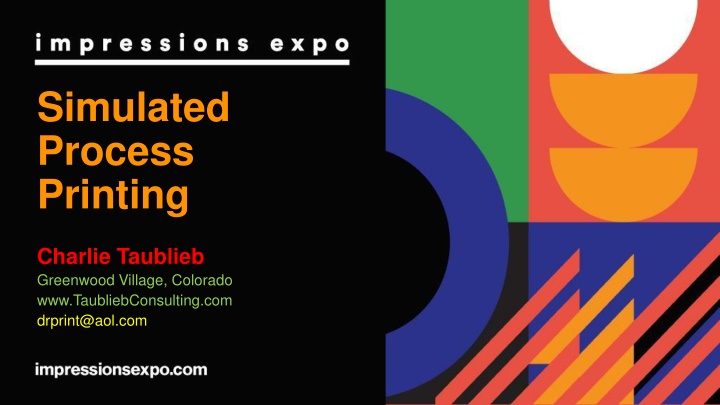
Simulated Process Printing Seminar Overview
This seminar by Charlie Taublieb delves into the intricacies of designing, separating, and printing colorful garments using plastisol inks in simulated process printing. Taught by a seasoned professional with decades of experience, topics include artwork design, half-tone dots, output devices, and screen making techniques. Join to gain insights on creating vibrant designs for black shirts and utilizing raster images effectively.
Download Presentation

Please find below an Image/Link to download the presentation.
The content on the website is provided AS IS for your information and personal use only. It may not be sold, licensed, or shared on other websites without obtaining consent from the author. If you encounter any issues during the download, it is possible that the publisher has removed the file from their server.
You are allowed to download the files provided on this website for personal or commercial use, subject to the condition that they are used lawfully. All files are the property of their respective owners.
The content on the website is provided AS IS for your information and personal use only. It may not be sold, licensed, or shared on other websites without obtaining consent from the author.
E N D
Presentation Transcript
Simulated Process Printing Charlie Taublieb Greenwood Village, Colorado www.TaubliebConsulting.com drprint@aol.com
Introduction This seminar will focus on everything necessary to be able to design, separate and print any color garments with plastisol inks. I will discuss everything from the LPI to dot shape and angle and the mesh to use. I have been in screen-printing for over 47 years. As a printer, I specialized in printing black shirts. I have been a technical consultant for over 45 years. 3/17/2025 Company Website/ Slide Number
Topics of Discussion The type of printing I will be discussing uses raster images as in Photoshop rather than vector images such as the ones produced in Illustrator or Corel Draw.
Designing Garments Design large images Easy to identify subject matter Very bold-strong colors Easy to identify subject from a distance Easy to see in low light conditions
Artwork Design on Black. Illustration Board Monitor Make the image jump by creating contrast. Use a lot of black Use the black of the shirt to create the shadows. Don t worry about being anatomically correct.
Half-Tone Dots LPI Options Manual Printer 45 LPI Automatic Printer 45-65 LPI Dot shape Elliptical Dot Angles 61 Degrees
Output Devices Ink Jet RIP Software Direct to Screen
Screen Making Screen Types Rigid Metal Wood Retensionable Newman Roller Frames Semi-Retensionable Shur-Loc EZ Frames
Screen Making Mesh count for the underlays 110 (43cm) 80 Microns-Fleece 156 (60cm) 64 Microns-T-Shirts Mesh count for colors 230 (90cm) 48 Microns Tension 35N/cm for all screens
Inks Color Matching Systems Transparent Opaque Florescent Water Base Standard HSA Discharge Silicone
Squeegees Squeegees Manual Underlay 55/90/55 Triple Durometer Colors 65 Durometer Automatic Underlay 55/90/55 Triple Durometer Colors 62/90/62 Triple Durometer 65/90/65 Triple Durometer
Special Squeegees Double Blade Squeegee 55/90/55-Front 62/90/62-Back Roller Squeegee Hot Head (Iron)
Floodbars -Automatic Floodbar Types Standard Wing Tipped Water Base Wing Tipped
Summary Big Designs Strong Colors Color on Color Single Point Light Contrast High Tension Fine Mesh Sharp Squeegees White-Flash-Wet on Wet
Charlie Taublieb Greenwood Village, Colorado www.TaubliebConsulting.com DrPrint@aol.com Cell +303-618-8955 Skype drprint2001 WhatsApp +1 303-618-8955 Academy of Screen & Digital Printing Technologies
